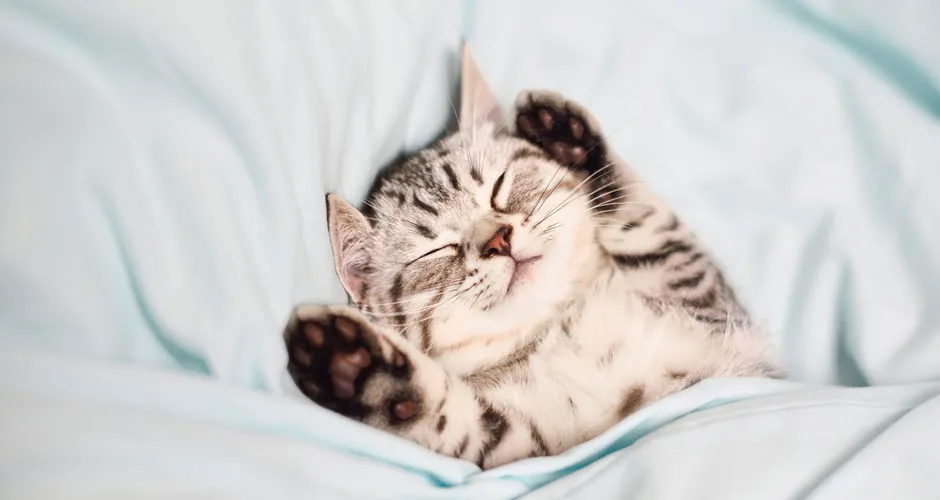Cats: you’ve probably got some questions about them. Questions like “Why do they purr?”, “Why has mine knocked over all the plants again?” and “Seriously, why would they knock them down just after I’ve hoovered?”
Although the latter behaviour is doubtlessly down to your moggy being a criminal mastermind, the reasoning behind feline purring isn't as clear. While many cat owners presume their pet purrs purely to display pleasure, research suggests those soothing vibrations can are made for several reasons – including an attempt to hijack your innate human psychology.
From the worrying, to undeniably cute, here is the strange science of why cats purr.
How do cats purr?
It should be an easy question to answer. But cats being cats have made things difficult here, their complex biology leading to a fierce debate among scientists. For instance, it was previously theorised that purring was caused by blood surging through the inferior vena cava – a large vein linking to the right side of the heart.
However, this so-called ‘turbulent blood theory’ has been swept into the litter tray, with research now suggesting the noise derives from a cat’s larynx. Essentially, felines can constrict the part of their larynx that touches their vocal cords, which causes vibrations with every inhale and exhale. As far as scientists now understand, we hear these vibrations as a purr.
Read more about cat behaviour:
- Why you’re stroking your cat completely wrong (and how to do it right)
- Why do cats knead?
- Eight mind-blowing facts about cats, according to science
Why do cats purr?
Currently, there’s no definitive explanation to why cats purr.
Scientists have identified a certain neural oscillator (brainwaves, essentially) that activates the biological process behind purring, but it’s not clear what triggers this. Or indeed, if there’s more than one trigger: findings based on observational studies suggest cats can purr for several reasons.
To communicate with others
For instance, one study conducted by the University of Sussex found that your cat can slightly vary their purrs depending on a certain need. “This research indicated a marked difference in the acoustic quality of purrs emitted by cats when attempting to solicit food from their owners, compared to when they were generally relaxed or being petted,” explainsDr Lauren Finka, feline welfare scientist at International Cat Care.
“Interestingly, these ‘food soliciting’ purrs were also perceived as more urgent and less pleasant-sounding by humans. They were also noted to include high frequency voiced components similar to those produced by human infants when crying.”
“Interestingly, the purrs indicating a cat was hungry actually shared aural signatures with the noises that hungry babies make when they're crying.”
Indeed, as the study found, hungry cats looking to be fed by their owner contained an unusual high-frequency element (akin to a human baby cry) within their naturally low-pitched purr. With these ‘solicited purrs’, domestic cats are effectively tapping into our own nurturing instincts to give them attention. Their cries of ‘feed me’ are hidden in what may sound like a pleasant purr.
"The embedding of a cry within a call that we normally associate with contentment is quite a subtle means of eliciting a response - and solicitation purring is probably more acceptable to humans than overt meowing,” study author Dr Karen McCombconcluded.
In other words, your moggy is an evil genius. And don’t pretend like you didn’t suspect it before.

They're healing from an injury
Experts have also theorised that your cat may actually be purring when they’re injured or in distress – the complete opposite of happy.
“It’s thought that in certain contexts, cats might also purr in an attempt to self-soothe, potentially helping them to feel calmer or to relieve pain. Indeed, cats are observed purring in situations where they are likely to be experiencing stress or physical discomfort," says Finka.
“In these situations, it might also be that they’re attempting to solicit help from us (as with the ‘food solicitation’ purr), although often their behaviour and body language in these contexts appear to suggest the cat would prefer to be left alone and not to be touched. Additionally, cats may also purr when humans aren’t present. Further research is therefore needed to help us better understand the various functions of purring in domestic cats."
Interestingly though, there is some evidence suggesting the purr prompts a healing effect in felines. One study published in the New Zealand Veterinary Journal indicated that the vibration of cat purrs (ranging from 20Hz up to 150Hz) could actually promote bone growth and heal soft tissue.
These results have yet to be replicated on cats, but subsequent studies have examined the potential of low-intensity vibrations in healing mice wounds. Although the exact mechanism behind how the vibrations assist healing isn’t understood, scientists noted it promoted the growth of crucial granulation tissue – connective tissue and microscopic blood vessels – around injured areas.
Despite these findings, no large-scale trials have investigated the effect on humans – if you ever cut yourself, a doctor is unlikely to advise holding a purring kitty to your open wound.
About our expert
Dr Lauren Finka, is a feline welfare scientist at International Cat Care and visiting fellow at Nottingham Trent Univeristy. Her research has been published in journals including PloS one and the Journal of Feline Medicine and Surgery.
Read more about the science of cats: